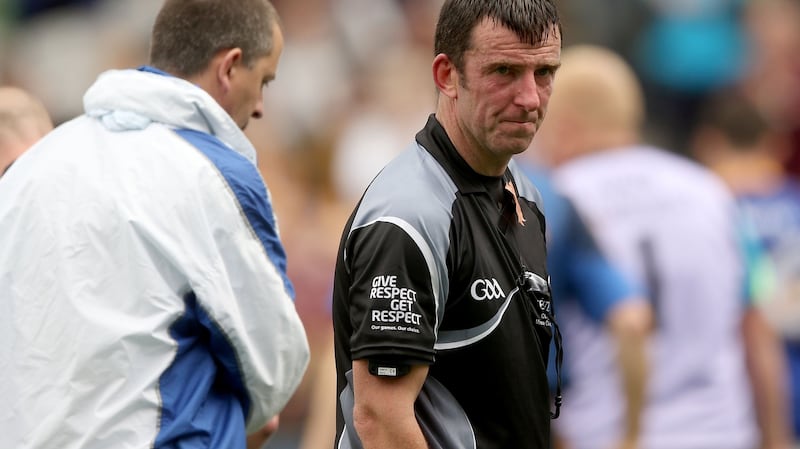Intercounty referees are now covering similar distances as players in the course of championship matches, with maximum top speeds not far off either.
Data collected throughout the 2017 hurling and football championships is aimed at assisting and improving referee fitness programmes – and shows they’re now covering just under 10km per game. Linesman, often seen to be standing still, are in fact covering close to 7km per game.
All 14 national hurling referees and the 20 football referees were tracked using GPS units throughout the championship (28 games in hurling, 63 games in football) by STATSports, who have their UK base in Newry, for research carried out by the GAA in association with Aidan Brady at DCU.
In hurling, the average distance covered was 9.64km, and slightly more in football (9.80km). The average number of sprints (>18km/h for more than 1sec) was 42 in hurling, with a maximum of 78; in football the average was 49, with a maximum of 90.
“We’re only starting to properly look at the match demands of referees during the championship, and certainly some of these numbers are surprising”, says Barry Watters, senior sports scientist at STATSports.
“They’re covering 9-10km on average, and that would be around the same for the average intercounty player. It might be higher for a half forward, midfield, but on average it’s 9.5 to 10km for the player as well.
“Over the 70 minutes, players would be doing three or even four times the number of high intensity runs, but all in all, referees cover same distance. We know how much work the players do to get in shape, and again the referees don’t often get the same credit. But the purpose here is to then base fitness tests and other markers at the start of the year, to help decide are they at the fitness standard necessary to referee senior championship matches.”

In football, the maximum top speed of the referee was 28.3km/h; in hurling it was 26.7km/h, again not far off the maximum top speed of the player – who would however be producing those runs with greater frequency.
Referees also cover more ground in football than hurling, despite the assumption hurling might be the faster game: the maximum distance covering in a championship match (11.70km) was also in football, slightly less (11.19km) in hurling.
“I was bit surprised at those numbers myself,” says Watters. “In hurling though the ball might go inside the 45m, then come straight back out again, so counters some of that out. The high speed numbers (7 per cent of runs) indicate as well that maybe referees do need to do more of a warm-up, and that’s something taken from the data before. The first two minutes of a championship match can often be the fastest, and it’s important the referees don’t pick up any injuries because they’re not warmed up, or ready for the game.
“With GAA players, Premier League players, this has been done before, where they look at the demands of the game, then work backwards, to make sure players are doing the right training to match those demands. It’s only now being done with referees, and they love getting the feedback to see exactly what those demands, and can then alter their preparations and conditioning. In the past they would have done a lot of long-distance training, not the high intensity stuff that they actually need.
“The venue can have an impact on this too, Croke Park obviously being a lot bigger than say Clones, or somewhere like that. The style of football and hurling being played can also have an impact, Ulster football say sometimes being that bit slower, with the more defensive systems.”
The average distance covered by the linesmen was 6.64km in hurling, 5.90km in hurling: “Most of the time when you’re looking at the linesmen they’re standing still, when actually they’re also covering a lot of ground, and would be close to some positions on the field, the full back line, or full forward line, average about 6-7km per match.
“Overall it’s helped a lot in the conditioning programmes being done up, an area under-studied, not just in GAA but across all sports. There isn’t much published data on exactly how much stress the referees are put under.”
STATSports also provide GPS units for a select number of county teams, including Dublin and Mayo.
2017 Referee and Linesmen Statistics
FOOTBALL
Distance
Average distance covered: 9.80km
Max distance covered: 11.70km
Average (Linesman): 5.90km
Max (Linesman): 6.97km
Speed
Max: 28.3km
Average Max Speed: 24km/h
Number of sprints (>18km/h for more than 1sec)
Max: 90
Average: 49
Distance breakdown
Walking (0.1-6.5km/h): 25%
Jogging (6.6-12km/h): 27%
Low intensity running (12.1-15km/h): 21%
Moderate intensity running (15.1-18km/h): 17%
High intensity running (>18km/h): 10%
HURLING
Distance
Average distance covered: 9.64km
Max distance covered: 11.19km
Average (Linesman): 5.97km
Max (Linesman): 6.64km
Speed
Max: 26.7km/h
Average Max Speed: 23.2 km/h
Number of sprints (>18km/h for more than 1sec)
Max: 78
Average: 42
Distance breakdown
Walking (0.1-6.5km/h): 29%
Jogging (6.6-12km/h): 25%
Low intensity running (12.1-15km/h): 22%
Moderate intensity running (15.1-18km/h): 17%
High intensity running (>18km/h): 7%
* The max distance in football (11.7km) was covered by Jerome Henry in the All-Ireland Round 2A, Laois vs Clare, in Portlaoise.
* The max distance in hurling (11.2km) was covered by Paud O’Dwyer in Round 1 of the All-Ireland qualifier between Tipperary and Westmeath at Semple Stadium in Thurles.

















